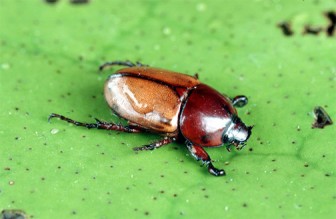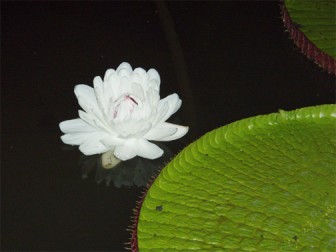The Giant Water Lily (Victoria amazonica) is a flowering plant and the largest of the Nymphaeaceae family of water lilies in the world. It is native to the shallow waters of the Amazon River basin and is depicted in the Guyanese Coat of Arms as it is the National Flower of Guyana.
After discovery and description in 1837, it was named ‘Victoria Regia’ after Queen Victoria of England and once named was the subject of rivalry in Victorian England as gardeners started a well-mannered competition to see who could cultivate and flower this enormous lily, not an easy task in temperate England when heating was provided by coal fuel only.
The leaves and flowers of these spectacular lilies can be seen floating in the still waters of the ponds and oxbow lakes of the Rupununi. The leaves are circular and can grow up to 3 metres in diameter; the leaves are joined by a submerged stalk that grows 7 – 8 meters in length and connects up the leaves.

The flower buds push up from underwater and in the evening, the petals slowly peel open to reveal a large, white, sweet-scented flower up to 40 cm in diameter. The sweet smell of the flowers lure in large beetles who dive into the flowers to collect pollen but quickly become drunk on the nectar. At dawn, the flower closes its petals, trapping its suitor beetle inside. The next evening, the flower opens once more, but during the day, it has changed colour and become pink, and the beetle is free to leave its sweet prison.

The pink colour is a signal to other beetles that it has already been pollinated and the beetles only approach the white flowers. This way, the lily ensures its genetic success and diversity though its relationship with the beetle.
You can witness this natural spectacle in the ponds around Rewa’s Grass Pond and in Karanambu Ranch in the Rupununi.
Rain forests are rich in biodiversity and are home to many different plants and animals. In addition, indigenous communities make their homes there. Even if you don’t live in the rain forest, humans rely on the forest for resources such as building materials (wood and lianas), medicine and fruits. Rain forests also provide essential environmental services for life on earth; they create soil as well as prevent soil erosion, produce oxygen though photosynthesis, maintain clean water systems, and are a key defence against climate change.
The Iwokrama Rain Forest is 371,000 hectares, located in the heart of Guyana. Our mission is to develop strategies for conservation and sustainable development for local people in Guyana and the world at large. We are involved in tourism, training, research and our timber is certified by the Forest Stewardship Council. Come and visit us in the rain forest or at http://www.iwokrama.org.




